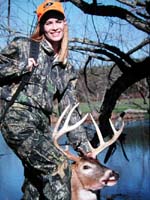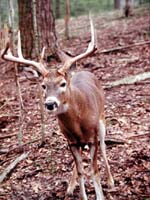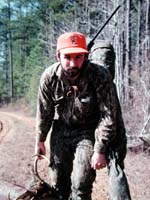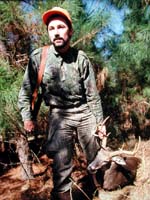
|
Features
|
|
|
|
Books
|
|
|
|
Fun & Games
|
|
|
|
Contact Us
|
|
|
John's Journal... Entry 128, Day 1
SECRETS OF DEER-HUNTING GUIDES
Locating Big Bucks
 EDITOR'S
NOTE: For some, deer hunting isn't just an
annual event, it's their livelihood. When they talk, you'd do well to
pay attention. A professional deer-hunting guide earns his living by finding
bucks for his clients every season. These avid woodsmen have spent their
lifetimes studying the habits and haunts of deer. They experience consistent
success because they know more and hunt more than the average outdoorsman.
True masters of the sport of deer hunting, deer-hunting guides have developed
common-sense tactics that will produce bucks for you anywhere you live.
EDITOR'S
NOTE: For some, deer hunting isn't just an
annual event, it's their livelihood. When they talk, you'd do well to
pay attention. A professional deer-hunting guide earns his living by finding
bucks for his clients every season. These avid woodsmen have spent their
lifetimes studying the habits and haunts of deer. They experience consistent
success because they know more and hunt more than the average outdoorsman.
True masters of the sport of deer hunting, deer-hunting guides have developed
common-sense tactics that will produce bucks for you anywhere you live.
LARRY NORTON: From Pennington, Alabama, Norton lives in the heart of the Black Belt, so named for its very fertile soils. Norton lives in a region that never has had a year without a deer season.
Norton has guided at several lodges near his home and has developed tactics to find and take bucks.
STRATEGY ONE - "In August and September in many parts of the country, droughts occur," Norton says. "During these dry-weather periods, whitetails have difficulty finding nutritious forage, and they can become very stressed. Most people think that the summer and early fall months have plenty of grass, but during drought conditions, this grass is dry and dead. The deer have to move and search for food.
 "In
my home state of Alabama, as in many other states, feeding deer is legal.
However, the law says that all food must be gone from an area and be off
the ground 10 days before hunting season begins. I put up Moultrie feeders
and fill them with corn in many locations throughout the lands I hunt.
I put the feeders about 1/2- to 3/4-mile apart. I've found that distance
allows me to feed different segments of the deer population. The feeders
provide nutritious food for the deer during a time of year when food is
hard to find. These feeders also concentrate the deer in one spot at a
particular time of day where I can observe the deer on that section of
land. By watching the deer in each area where I have a feeder, I can determine...
"In
my home state of Alabama, as in many other states, feeding deer is legal.
However, the law says that all food must be gone from an area and be off
the ground 10 days before hunting season begins. I put up Moultrie feeders
and fill them with corn in many locations throughout the lands I hunt.
I put the feeders about 1/2- to 3/4-mile apart. I've found that distance
allows me to feed different segments of the deer population. The feeders
provide nutritious food for the deer during a time of year when food is
hard to find. These feeders also concentrate the deer in one spot at a
particular time of day where I can observe the deer on that section of
land. By watching the deer in each area where I have a feeder, I can determine...
* how many bucks I have in that region,
* what the biggest buck is on that part of the property and
* what the buck/doe ratio is in that area.
"In one place where I fed deer last year, I saw 11 bucks. The dominant buck coming to that feeder only was a six-point. Three quarters of a mile from that feeder, five bucks regularly visited another feeder. The biggest buck in that area was a 10-point that would have scored in the 150-point class on the Boone & Crockett scale. In yet another region where I fed the deer, most of the animals that came to the feeder were does.
 "From
my research, I've learned that usually the largest and most dominant buck
that comes to a feeder will remain in the general region where you see
him, since this is his core area. The other bucks may disperse during
or just prior to the rut from this section of land. Feeding the deer tells
me I have a trophy buck to hunt, and I understand where to begin to hunt
him.
"From
my research, I've learned that usually the largest and most dominant buck
that comes to a feeder will remain in the general region where you see
him, since this is his core area. The other bucks may disperse during
or just prior to the rut from this section of land. Feeding the deer tells
me I have a trophy buck to hunt, and I understand where to begin to hunt
him.
"I need to hunt the feeding-station areas that have
a large concentration of does and few if any bucks during the rut. The
regions with the highest populations of does draw the older age-class
bucks which search for does during the breeding season. Generally, I'll
sit my feeders on the edges of a field, a clear-cut or other open spots
where I can see from a great distance. Before the season when I go to
observe the deer at the feeders, I make sure I have a favorable wind so
the deer will not smell me. I wear Mossy Oak camouflage from head to toe
to keep the deer from seeing me. I take a stand about 150 yards away from
the feeder and use binoculars. I wear a scent eliminator to kill my human
odor and use fox urine as a cover scent. I take every precaution to not
let the deer know I'm in their area. Then before deer season arrives,
I take the feeders down in plenty of time to be certain no corn is on
the ground to comply with the law. I'm not using the feeders to bait deer.
"I feed deer so I can observe the deer in a region. Then I'll know
whether or not I have a trophy buck to hunt. Using this strategy, I don't
waste my time hunting a place where no trophy buck lives."
 To
learn more tips for taking deer, go to Night Hawk Publications' home page
and click on books.
To
learn more tips for taking deer, go to Night Hawk Publications' home page
and click on books.
TOMORROW: MORE STRATEGIES FOR FINDING AND TAKING BUCKS
Check back each day this week for more about Canadian Black Bears ...
Day 1 - Locating Big Bucks
Day 2 - More Strategies for Finding and Taking
Bucks
Day 3 - Walker's Tips For Taking Monster
Bucks
Day 4 - Bad-Weather Deer-Hunting Tactics
Day 5 - Pitman Consistently Takes Bucks